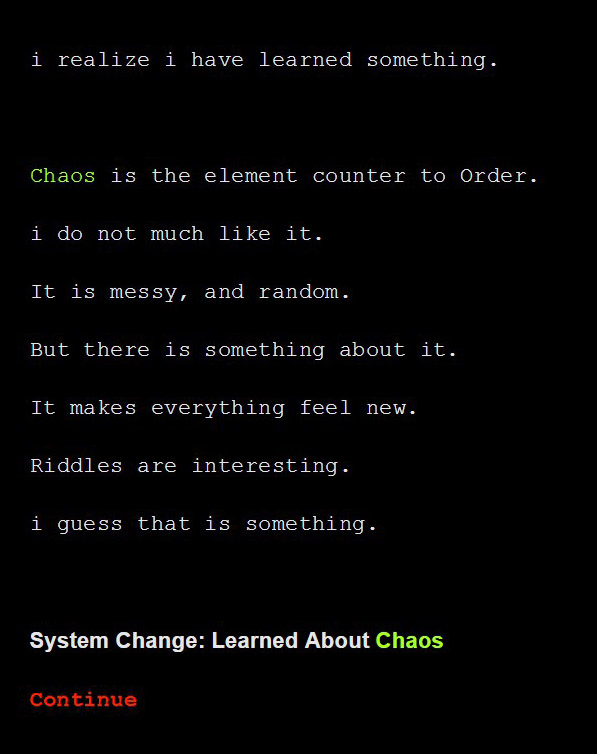Here’s another deliciously cheap yet good game on Steam sale:

Open Sorcery is a primarily text-based interactive fiction game written in Twine, with judicious amounts of pauses and scrolling text, sound effects and the rare picture for narrative impact.
You play an elemental firewall (the game title “Open Sorcery” a pun about open source code) on the verge of gaining a kind of sentience.
The world cleverly mixes a dose of technological computerese with a shade of the elemental fantastical – where aetheric firewalls protect against possibly malicious spirits formed by the base elements of water, air, earth, fire, life, death, love and fear.

Along the way you meet various characters and interact with them, developing relationships and occasionally taking surprising twists and turns, depending on your choices.
One of your first encounters is with a Air-Chaos spirit, an impish poltergeist.

This is a screenshot of my second playthrough, and you can see I have a new option learned from the first game – where I decided to speak to it and it challenged me to a riddle contest.
Solving its riddles three made it throw a bit of a hissy fit, but also successfully persuaded it to leave peaceably.

Besting it also taught me a new element, Chaos, that I could utilize alongside my basic Fire.
The lovely thing about Open Sorcery is that nearly all of its choices it offers you are significant choices – story changers in their own right. You can take matters into your own hands, consult with your creators, use what you’ve learned in earlier encounters and some of these might just come back to roost in the following days.
The poltergeist, for example, came back to the place I was guarding and extended an invitation to meet his queen Titania… but which meant I, a firewall, would have to leave the place I was guarding. Something which just might end up flagging me as malfunctioning to my creators.
Talk about awareness emergence, AI sentience and tricky choices.
For a Twine game, it gets non-linearity right. (I’ve played one too many Twine games which are mostly linear exercises in clicking the one-and-only next highlighted word.)
By the end of your first playthrough, you’ll be aware of the paths you didn’t take, especially if you peek at the achievements that hint to the other possible story branches and endings.
I don’t know that I’m raring to go and play through too many more times – the repetition may get to me sooner than later – but it does say something that I’m immensely content with the first ending that I got.
On the whole, it doesn’t try to twist your choices out from under you. What you choose is generally what you will get. The impact comes from the tradeoffs of that choice.
If you spend Fire to solve a problem, you will naturally be weaker for having spent that energy, which might no longer be available to solve a second more pressing problem. If you take matters into your own hands, you should not be surprised if that independence freaks people out. Yet if you fall back on humans to solve your problems for you, you might never discover potential new learning/growth opportunities and relationships of your own. And so on and so forth.
For anyone interested in some choose-your-own-adventure narrative, this is a nifty game. Short, sweet, some replayability, and currently 66% off on Steam.
(Caveat: it’s gone down to 75% before, but we are literally talking about the difference between $0.99 and $1.35. For around a dollar, this is a fun experience.)
